The pregnane X receptor (PXR,
NR1I2) is a xenobiotic-activated transcription factor with high levels of expression in the liver. It not only plays a key role in drug metabolism and elimination, but also promotes tumor growth, drug resistance, and metabolic diseases. It has been proposed as a therapeutic target for type II diabetes, metabolic syndrome, and inflammatory bowel disease, and PXR antagonists have recently been considered as a therapy for colon cancer. The identified allosteric sites of the PXR provide new insights into the development of safe and efficient allosteric modulators of the PXR receptor. Researchers therefore propose that novel PXR allosteric sites might be promising targets for treating chronic metabolic diseases and some cancers.
) is a xenobiotic-activated transcription factor with high levels of expression in the liver. It not only plays a key role in drug metabolism and elimination, but also promotes tumor growth, drug resistance, and metabolic diseases. It has been proposed as a therapeutic target for type II diabetes, metabolic syndrome, and inflammatory bowel disease, and PXR antagonists have recently been considered as a therapy for colon cancer. The identified allosteric sites of the PXR provide new insights into the development of safe and efficient allosteric modulators of the PXR receptor. We therefore propose that novel PXR allosteric sites might be promising targets for treating chronic metabolic diseases and some cancers.
- PXR
- pregnane X receptor
- allosteric site
- CAR
- colon cancer
- BF 3
- nuclear receptor
1. Introduction
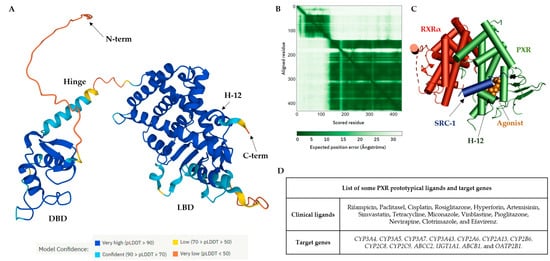
2. The Orthosteric Ligand-Binding Pocket of the PXR
The PXR shares common structural characteristics with other nuclear receptors [43]. The orthosteric binding site of the PXR receptor is large (>1600 Å3), dynamic, and flexible enough to bind bulky ligands [40]. The PXR LBD is characterized by an alpha-helical sandwich structure with a specialized five-stranded beta sheet [44]. The LBP is deeply embedded in the PXR LBD (Figure 2A) [45]. The orthosteric PXR LBP is formed by the helices α3/5/6/7/10/12 (Figure 2B) [46]. The PXR ligand-binding cavity was detected at the bottom of the LBD, with the ligand entrance located between the alpha 2 and 6 helices (Figure 2B) [40][44][40,44]. The PXR was observed as a homodimer in solution, and the crystal structure showed linking with β1′ strands and with support by six intermolecular hydrogen bonds in the monomer [43]. The PXR LBD shares structural similarities with the VDR and CAR, with a sequence homology of 49.4% and 48.6%, respectively. In humans, the main isoform of the PXR (NM_003889.4, variant 1) consists of 434 amino acids, and the main hydrophobic hot spots are the amino acid residues F288, W299, and Y306, which interact with all reported co-crystallized PXR ligands [40]. All available 49 PXR LBD crystal structures represent the PXR receptor in its active state and are available for coactivator interactions through helix 12 (H12) for the following transcriptional activation. Due to the destabilization of the PXR LBD, to date no crystal structure of a PXR antagonist has been reported. Therefore, as an alternative to crystallography, the biophysical technique of hydrogen-deuterium exchange mass spectrometry (HDX-MS) was used to analyze the PXR–antagonist interactions [41]. The structural characteristics of PXR ligands are determined by the nature of the PXR binding pocket: (i) the PXR LBP is large and highly hydrophobic; and (ii) the polar residues Ser247, Gln285, His407, and Arg410 define the ligand binding position in the PXR LBP via strong hydrogen bond (H-bond) interactions. Ser247 and Gln285 residues are involved in the orientation of the ligand binding and the His407 and Arg410 side chains are flexible to accommodate various sizes of ligands in the LBP [47]. Recently, a detailed examination of the PXR antagonist/inverse agonist SPA70 binding has been conducted. The distinction of the PXR antagonist/inverse agonist (SPA70) from agonist (SJB7) binding showed that the agonist should have the hydrogen bond to the polar residue of Ser247 in helix 10 as well as proximity to the helix 12 region. In contrast, the antagonist has interaction with Ser247 residue and/or has weak contacts with helix 12 [39]. Since the PXR agonist SJB7 and the antagonist SPA70 bind to the same ligand-binding pocket in the PXR in the combined agonist and antagonist conformation, it is difficult to discriminate agonist and antagonist binding sites in the PXR LBD [39][41][39,41]. Notably, a single PXR LBP mutation (W299A) converts the activity of SPA70 from inhibition to activation [48]. It has recently been reported that the designed PXR molecular glue SJPYT-195, which is composed of SPA70 linked with the CRBN ligand (thalidomide), degraded the GSPT1 translation termination factor instead of the PXR [49], but the loss of GSPT1 decreased the level of PXR protein in human colon cancer cells (SNU-C4) [49]. SJPYT-195 weakly bound the PXR LBD, suggesting that long-length linkers may be more favorable in the design of potent PROTACs for PXR [49][50][49,50]. RWesearchers can also speculate that PXR allosteric sites could be another strategy for the successful targeting of PXR protein degradation (Figure 2) [51].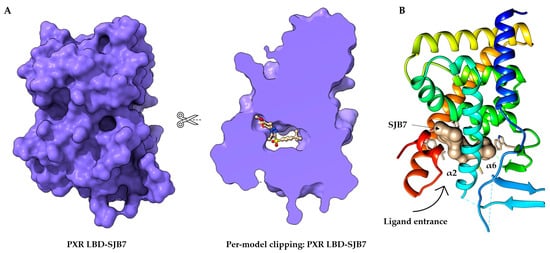
3. Allosteric Modulation of Nuclear Receptors
Allosteric modulators are usually structurally different from orthosteric ligands, and they bind to distinct sites that are spatially distant from orthosteric sites to modulate the activities of orthosteric ligands [53]. The essential features of a receptor allosteric modulation are: (1) orthosteric and allosteric sites not overlapping, i.e., there is no mutual biomolecular interaction in the binding; (2) the allosteric binding of one ligand to its site can affect the binding of the second ligand to the orthosteric site and vice versa; and (3) the effect of allosteric modulation can be positive or negative depending on the existing orthosteric ligand. This phenomenon is known as “probe dependence” [54][55][54,55]. Allosteric modulation may be inhibited due to protein–protein interactions (e.g., nuclear receptor–coactivator) or a co-bound receptor, such as in the case of the nuclear receptor homodimerization and heterodimerizations as was reported for G protein-coupled receptors [56]. Figure 3 represents the classification of the allosteric modulators and their allosteric properties: affinity modulation, efficacy modulation, reciprocity, and ceiling effect. Affinity modulation indicates the change in the structural conformation of an orthosteric LBP such that the binding affinity of an orthosteric ligand increases or decreases [57]. Efficacy modulation denotes the increase/decrease in intracellular responses (intrinsic efficacy), depending on the orthosteric ligands (agonist or antagonist) [57]. The ceiling effect or the saturability effect means that allosteric modulators are non-competitive and maintain a certain saturation level at a certain concentration [58]. Allosteric modulators may display the possibility of an absolute subtype selectivity for a target protein. For example, a 1700-fold selective allosteric inhibition for phospholipase D1 (PLD1) compared to its subtype PLD2 has been reported [59]. Allosteric modulators may improve the efficacy and potency of an agonist (e.g., from 2 to 100-fold) in a receptor or may have a synergistic effect [60][61][60,61]. Furthermore, reciprocity or allosteric activation may occur [54], which means that the receptor is activated directly, without the presence of an orthosteric ligand [62].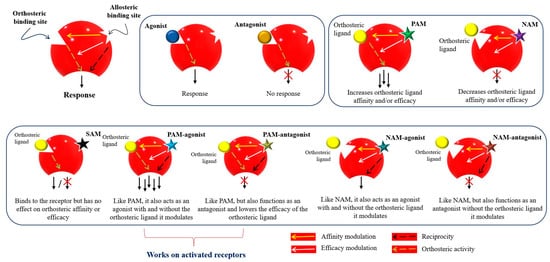
3.1. Allosteric Targeting of the Pregnane X Receptor (PXR)
3.1.1. Duplex—Synergistic Activation of the PXR LBD
The PXR LBD is able to bind two synthetic ligands concomitantly to the orthosteric ligand binding site (Figure 4A) [70], a phenomenon which has been described previously for the PPARγ and ERβ nuclear receptors [71][72][71,72]. Two or more compounds accommodate the same binding sites in the receptors and occupy a space within the canonical LBP near the helix 3 region, leading to enhanced coactivator binding, transactivation, and target gene expression [70][71][72][70,71,72].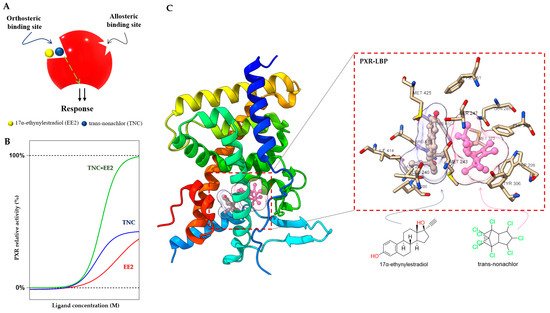
3.1.2. The AF-2 Binding Site at the PXR LBD and Its Ligands
It was found that ligands binding to the AF-2 function of the PXR alter the interactions between a coregulator peptide and the PXR. The ligand-dependent groove of the AF-2 is made up of helixes 3, 4, 5, and 12, which are mainly hydrophobic regions [37]. The orthosteric PXR LBP ends with a short helix 12 (H12), which is important for the structural organization of the AF-2 region to recruit transcriptional coregulators. Coregulators play an important functional role in the transduction of PXR signals. Both corepressors and coactivators bind to the AF-2 regions through a short amphipathic helical sequence containing the Leu-Xxx-Xxx-Leu-Leu (LXXLL) motif in coactivators or Ile/Leu-Xxx-Xxx-Ile/Val-Ile motifs in corepressors via an electrostatic interaction [75][76][75,76]. When the binding of a ligand is performed, helix H12 undergoes a significant conformational structural change that alters the overall shape of the AF-2 binding site. The PXR ligands alter the AF-2 site after binding into the PXR LBP, and thus modify the recruitment of coactivators or corepressors, resulting in different agonist or antagonist effects of the ligands [77]. All available PXR antagonist molecules act through similar agonist activation mechanisms, except for some AF-2 disruptors (Figure 5). The PXR’s ligand binding site is the same for both agonists and antagonists, but there are small residue differences with helix 12 [39][40][78][39,40,78]. In addition, none of the identified AF-2 site binding antagonists possess allosteric properties (selectivity, efficacy, or affinity) (Table 1) [54]. Targeting of the AF-2 site always involves issues of nuclear receptor selectivity because the AF-2 site is structurally conserved across subtypes of the nuclear receptor family [78][79][78,79]. For example, ketoconazole, the first identified PXR AF-2 site allosteric modulator and antagonist, is a common inhibitor of activated PXRs, CARs, LXRα/βs, and FXRs [80][81][80,81]. Ketoconazole binding to the surfaces of the AF-2 site suggests that ketoconazole directly blocks a coactivator (e.g., SRC-1) binding, a finding which was confirmed by a double mutant model (T248E/K277Q) in the AF-2 region of the PXR [81]. The phytoestrogen coumestrol is a natural PXR antagonist proposed to bind to a non-LBP. Biochemical binding assays and LBP-filled mutant (obliterating) studies confirm their surface binding is distinct from the orthosteric site of the LBP [82]. Additionally, computational pharmacophore and docking analyses showed that the known PXR antagonists coumestrol and sulforaphane also accommodate the AF-2 ligand-binding site [83]. In another study, the azole compound FLB-12, a derivative of the azole antifungal ketoconazole, antagonized activated PXRs in the hepatocyte cell line and in in vivo models. The triple mutant plasmid of the PXR LBP (S247W/S208W/C284W) was used to confirm its binding sites outside the PXR LBP. FLB-12 disrupts the interaction between the PXR and SRC-1, a finding which was verified by the protein pull-down assay, indicating the location of binding into the AF-2 sites. This antagonist was found to be selective and less toxic as compared to ketoconazole [84]. Ekins et al. reported residues of the PXR AF-2 ligand binding site. The identified AF-2 ligand binding site is predominantly hydrophobic, and it consists of 15 amino acids (Lys252, Ile255, Lys259, Phe264, Ile269, Glu270, Gln272, Ile273, Ser274, Leu276, Lys277, Pro423, Leu424, Glu427, and Leu428). Lys277 probably serves as a “charge clamp” for the interaction between the coactivator SRC-1 (His687) and the PXR, and it may play a significant role in the initial phase of accommodation of azole molecules into the binding groove of the PXR. Two more azole analogs, enilconazole and fluconazole, have also had interactions confirmed with the AF-2 ligand binding site, as well as antagonist activity shown towards the PXR [80][85][80,85].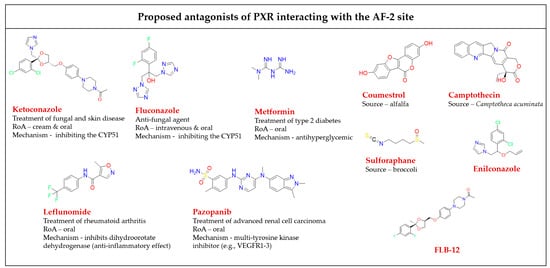
| Molecules | PXR Biological Properties | Binding Site | Reference | |||
|---|---|---|---|---|---|---|
| Efficacy (IC | 50 | ) | Affinity (Ki) | NR Selectivity | ||
| Ketoconazole | 74.4 µM | 55.3 µM | Non-selective | AF-2 | [80] | |
| Coumestrol | 12 µM | 13 µM | Non-selective | AF-2/LBP | [82] | |
| Enilconazole | ~20 µM | NA | NA | AF-2 | [80][83] | [80,83] |
| Fluconazole | ~20 µM | NA | NA | AF-2 | [80][83] | [80,83] |
| FLB-12 | ≥23 µM | NA | Selective | AF-2 | [84] | |
| Leflunomide | 6.8 µM | NA | Non-selective | AF-2 | [83][90] | [83,90] |
| Sulforaphane | 12 µM | 16 µM | Selective | AF-2 | [83][89] | [83,89] |
| Metformin | NA | >1 mM | Non-selective | AF-2 | [87] | |
| Camptothecin | 580 nM | NA | Non-selective | AF-2 | [88] | |
| Pazopanib | 4.1 µM | NA | Selective | AF-2 | [86] | |
| Pimecrolimus | 1.2 µM | NA | Selective | AF-2/LBP | [86] | |
| 73 | 8.3 µM | NA | Selective | AF-2 | [42] | |
